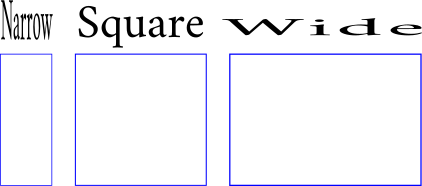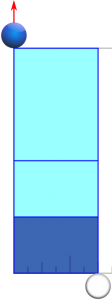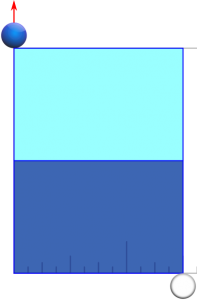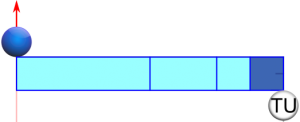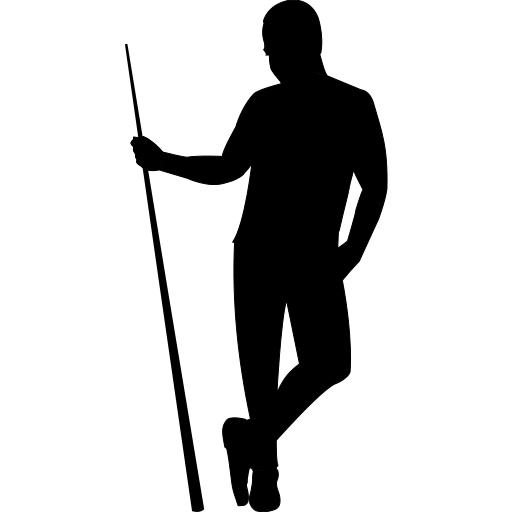Rectangle Groups
As we hone in on a shot label, it can be very helpful to quickly rule out all shot rectangles that could not possibly match the current shot setup. A very practical application of the rectangle groups method described on this page is the quick detection of whether a shot is just above, just below or exactly ‘AB’, ‘B’, ‘C’, ‘E’, or ‘Q’.
Although each shot rectangle is unique, it can share certain qualities with other shot rectangles. These shared qualities allow us to organize all shot rectangles into groups. Knowing the qualities of each group, we can quickly determine the current shot’s group and therefore rule out all of the shot labels that belong to other groups. There are a total of nineteen groups—nine groups for shots under 45°, nine groups for shots over 45°, and a shared 45° group. We will focus on the 45° and under groups, since the over 45° groups are simply rotated reflections.
Narrow, Square or Wide?
Before we learn the unique qualities of each group, let’s define the “width” of a rectangle. For our purposes, any rectangle can have only one of three widths—narrow, square or wide.
A “narrow” rectangle simply means that its left and right sides are the longer sides and its top and bottom sides are the shorter sides.
A “square” rectangle is simply a square with all four sides of equal length.
A “wide” rectangle simply means that its left and right sides are the short sides, and its top and bottom sides are the long sides.
Aside: Using these definitions, the only shot rectangle with a width of “square” is the ‘Q’ shot rectangle. All other shot rectangles would be “narrow,” since their left and right sides would be the same length as ‘Q’, but their top and bottom sides would always be shorter than ‘Q’. I mention this as an aside, because we will not be applying the narrow, square, wide qualities directly to the shot rectangles but to the “subrectangles” that live inside of them.
SubRectangles
As we just learned, a shot rectangle can be built from stacked subsquares, but it can also be built from stacked subrectangles. Subrectangles are created when we divide a single rectangle into two equal rectangles. We simply draw a line across the middle of the rectangle to split it into two.

The resulting subrectangles can be divided again and again to create more and more subrectangles.
Subrectangles are the rectangles that will adopt our narrow, wide and square qualities. As we divide shot rectangles into smaller and smaller subrectangles, the rectangle widths go from narrow to square and finally to wide.



It is the number of divisions before arriving at a width that is either square or wide that distinguishes one group from the others.
After dividing a shot rectangle into two subrectangles, we divide just one of the two subrectangles if further dividing is necessary. We stop dividing when we sense that the width of a new subrectangle is either square or wide.
The groups are named for the range of shot rectangles they contain followed by their division sequences. The division sequences are in order from first to last subrectangle width quality.
45° and Under Groups
1) Below AB: Narrow|Narrow|Narrow|Narrow
The shot rectangle is Narrow. Therefore, we draw a line across its middle to reveal two new Narrow subrectangles.
![]()
A line drawn across the middle of one of the new subrectangles reveals two more Narrow subrectangles.
![]()
A line drawn across the middle of one of the new subrectangles reveals two more Narrow subrectangles.
![]()
A line drawn across the middle of one of the new subrectangles reveals two more Narrow subrectangles.
![]()
This is the only group where we stop at a Narrow width quality. This is because once we’ve divided three times and the new subrectangle remains Narrow, we know that our shot label is below ‘AB’ and have only ‘A’ and ‘A+’ to choose from.
0° to 3.5° is the shot angle range of the Below AB group.
2) AB: Narrow|Narrow|Narrow|Square
We draw a line drawn across the shot rectangle’s middle to reveal two new Narrow subrectangles.
![]()
A line drawn across the middle of one of the new subrectangles reveals two more Narrow subrectangles.
![]()
A line drawn across the middle of one of the new subrectangles reveals two more Narrow subrectangles.
![]()
A line drawn across the middle of one of the new subrectangles reveals that each of the two new subrectangles is Square.
3.6° is the shot angle of ‘AB’.
3) Between AB and B: Narrow|Narrow|Narrow|Wide
We draw a line drawn across the shot rectangle’s middle to reveal two new Narrow subrectangles.
![]()
A line drawn across the middle of one of the new subrectangles reveals two more Narrow subrectangles.
![]()
A line drawn across the middle of one of the new subrectangles reveals two more Narrow subrectangles.
![]()
A line drawn across the middle of one of the new subrectangles reveals that each of the two new subrectangles is Wide.
3.7° to 7° is the shot angle range of the Between AB and B group.
4) B: Narrow|Narrow|Square
We draw a line drawn across the shot rectangle’s middle to reveal two new Narrow subrectangles.

A line drawn across the middle of one of the new subrectangles reveals two more Narrow subrectangles.

A line drawn across the middle of one of the new subrectangles reveals that each of the two new subrectangles is Square.
7.1° is the shot angle of ‘B’.
5) Between B and C: Narrow|Narrow|Wide
We draw a line drawn across the shot rectangle’s middle to reveal two new Narrow subrectangles.

A line drawn across the middle of one of the new subrectangles reveals two more Narrow subrectangles.

A line drawn across the middle of one of the new subrectangles reveals that each of the two new subrectangles is Wide.
7.2° to 13.9° is the shot angle range of the Between B and C group.
6) C: Narrow|Square
We draw a line drawn across the shot rectangle’s middle to reveal two new Narrow subrectangles.

A line drawn across the middle of one of the new subrectangles reveals that each of the two new subrectangles is Square.
14° is the shot angle of ‘C’.
7) Between C and E: Narrow|Wide
We draw a line drawn across the shot rectangle’s middle to reveal two new Narrow subrectangles.
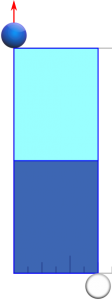
A line drawn across the middle of one of the new subrectangles reveals that each of the two new subrectangles is Wide.
14.1° to 26.5° is the shot angle range of the Between C and E group.
8) E: Square
We draw a line drawn across the shot rectangle’s middle to reveal that each of the two new subrectangles is Square.
26.6° is the shot angle of ‘E’.
9) Between E and Q: Wide
We draw a line drawn across the shot rectangle’s middle to reveal that each of the two new subrectangles is Wide.
26.7° to 44.9° is the shot angle range of the Between E and Q group.
10) Q
We see that our shot rectangle is square, so we know that the shot label is ‘Q’.
45° is the shot angle of ‘Q’.
45° and Over Groups
The groups for 45° and over follow the same sequences, but the Wides and Narrows are reversed.
1) Above U-: Wide|Wide|Wide|Wide
2) U-: Wide|Wide|Wide|Square
3) Between U- and TU: Wide|Wide|Wide|Narrow
4) TU: Wide|Wide|Square
5) Between TU and T: Wide|Wide|Narrow
6) T: Wide|Square
7) Between T and S: Wide|Narrow
8) S: Square
9) Between S and Q: Narrow
10) Q
With practice you’ll begin to sense the narrowness or wideness of the shot rectangles themselves, and with a glance be able to rule out nearly all that don’t fit the current shot.

